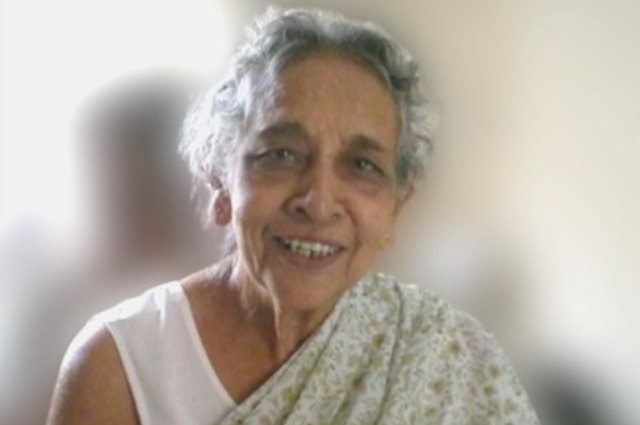
This was my grandmother (Mother’s mother) – Shanta Devi Sharma a.k.a. Nani! She wasn’t famous, didn’t run a business, and never wrote a recipe book. But every summer, like clockwork, she performed a ritual that made her unforgettable—not just to our family, but to anyone lucky enough to receive a jar of her aam ka aachaar.
In our household, Nani ka aachaar wasn’t just something on the side of the plate. It was the main event. A symbol of summer. A flavor that defined our childhood. Long before phrases like “organic,” “slow food,” or “gut-friendly” filled our Instagram feeds, Nani was out there—hand-picking mangoes, sun-drying ingredients, and grinding spices with the kind of love no machine can match.
Her hands held stories. And through her aachaar, she passed those stories down—not in words, but in taste.
Summer meant Mangoes and mangoes meant aachar!
In most Indian households, summer doesn't just mean heatwaves and school holidays. It signals something far more nostalgic—the arrival of mango season. Not just for juicy slices or milkshakes, but for something sacred: aam ka aachaar. And in our home, that meant only one thing—Nani was getting ready.
There were no shortcuts in my grandmother’s kitchen—especially not when it came to mango pickle season. As soon as the mangoes began appearing in markets, Nani would come alive with a quiet urgency. There was planning to do, spices to stock, jars to clean. But first came the mangoes. She believed in hand-picking each one herself, never relying on shopkeepers or shortcuts.
Dressed in her crisp, fresh cotton saris and armed with a cloth bag and a sharp eye, she’d make her way to the bustling city market, weaving through fruit stalls, spice vendors, and the noisy barter. She wasn’t there to buy just any mangoes—she had her standards. Each mango was picked up, examined, turned over in her hand like a gemstone. She had her own internal checklist: firmness, tartness, a certain shine. “Too soft,” she’d mutter, rejecting one. “Too fibrous,” she’d say, setting another aside. No one dared rush her. She wasn’t just buying mangoes; she was selecting the soul of her summer.
I would tag along with my mom, half-bored, half-fascinated. I didn’t know then that I was witnessing a ritual. Every year, this process unfolded like a family tradition. Predictable. Sacred. Unquestioned. In many Indian homes, especially back then, aachaar wasn’t just a condiment—it was tradition in a jar.
Back home, the real work began. The mangoes would be washed, then laid out on cloths to dry, wherever sunlight filtered in. The kitchen would transform into a laboratory of scents. She liked the mangoes cut a certain way, a certain size, and there were only a handful of people allowed to assist her. These were then sprinkled with salt and turmeric (haldi) and were covered and stored away for the night.
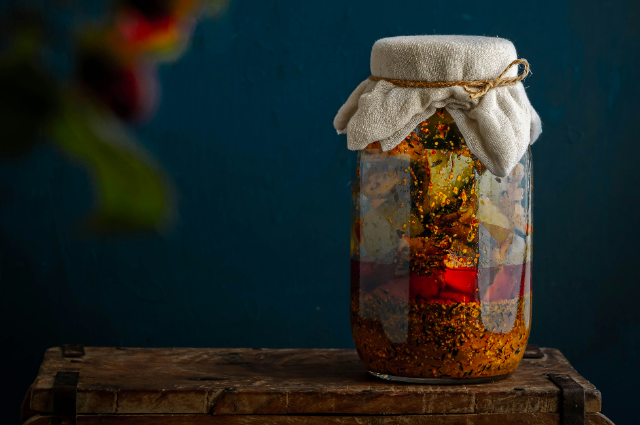
Photo by Prchi Palwe on Unsplash
I never asked her for the recipe. I thought she'd always be around. She isn't. And neither is her mango pickle. But I can still remember the exact taste: sharp, tangy, spiced with love and patience. I’ve tried commercial pickles—nothing comes close. Because the missing ingredient, I now realize, isn’t a spice. It’s her.
The Making: Spice, Oil, and Magic
Once the mangoes were sun-dried to perfection, Nani would begin the part that felt the most sacred—the mixing, grinding, stirring, and bottling of summer. She never followed a written recipe. Everything she needed was stored in her fingers, her eyes, her nose. Mango pieces were gently patted dry and left to rest, as the kitchen slowly transformed into a swirl of aromas—roasted spices, warm mustard oil, and that sharp, unmistakable scent of hing that announced to the whole house: aachaar ban raha hai.
She ground her spices by hand, her bangles softly clinking as if they were part of the rhythm. She didn’t rush. Every step had intention. A taste here, a whiff there. At just the right moment, she would heat oil in her seasoned skillet, letting the mustard seeds pop like tiny firecrackers before adding a pinch of hing. Then she’d turn off the flame, set the pan aside, and wait—for the oil to cool, for the aroma to mellow. Only once it was ready would she stir in a bit of jaggery, watching it melt gently into the warmth. This wasn’t just cooking—it was timing, memory, instinct. A quiet ritual passed down not through words, but through watching and doing.
Years later, my mother carried on the tradition. Her version was more measured—less oil, milder spice, better for the body, she said. And she was right. But something had changed. The ritual wasn’t repeated every summer, though she began making karonda ka aachaar from the tree on our terrace. Dozens of jars, year after year. That became her own ritual, one she followed faithfully—until recently. After years of bearing fruit, the tree died. When I ask my mom why she didn’t make the mango pickle, she says, “There is a lot of aachar in the cupboard. Let’s finish that first.” And there it was—the subtle difference between Nani and Mom. For Nani, it was tradition. For Mom, it was practicality.
I believe that it was always in the pace, in the silence, in the instinct that can’t quite be transferred. Nani’s pickle had that invisible something—maybe time, maybe touch. And with her, that essence quietly slipped away.
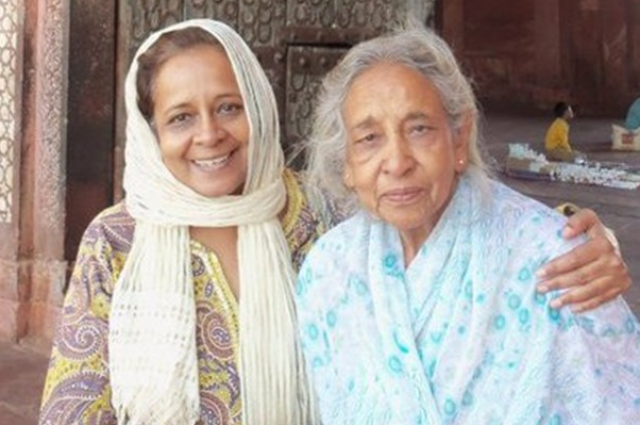
Two Pickles, Two Women: Nani and my mother
The Jars: Bottling Summer

The Aachar ki barni
You always knew pickle season had officially begun when this jar appeared. Tall and stout with a glossy brown crown and a soft cream body, it had a presence—like a guest who arrived only once a year, but whose visit meant everything. In our home, it was never referred to as a jar. It was the aachaar ki barni. No plastic container or steel box dared stand beside it. This jar had seniority, legacy, and purpose.
Nani kept these jars like a small army, ready and waiting as soon as the mixing began. After days of drying, grinding, heating and stirring, the final act of bottling was almost ceremonial. She would pour the mixture with quiet care, as if feeding the jar itself—making sure not a single mango piece was left behind, nudging even the last drops of spiced oil with her fingers. “Sab jaaye andar… ek boond bhi zaya nahi,” she’d murmur, her hands steady, her pace unhurried—no spills, no shortcuts, only love. And once full, the lid was sealed with cloth before being closed tight.
I remember being told not to touch them. “They need stillness,” she’d say, as though speaking about newborns. But of course, I would sneak peeks.
Even after Nani passed, the jars remained. My mother still makes the pickle, though not in the same volume or with the same drama. She prefers smaller jars now—easier to handle, easier to clean. The oil is lighter, the spice more controlled. Her reasons are valid—health, hygiene, balance. And yet, every time I see one of those older jars pushed to the back of a shelf, my heart tugs. Because it’s not just a container to me. It’s the vessel that held an entire season. An entire woman.
The barni didn’t just store pickle. It stored stories. It bottled time, and in its weight, its shape, its stubborn refusal to fade into the background, it continues to hold everything Nani stood for—without ever needing a single word.
The Mangoes Waited, But She No Longer Came
Nani passed away in 2016 in the Himalayas, surrounded by nature with her son, Sushil. Her last few years were hard, as she had dementia. Memories began to fade and with it the memories of aachar. The woman who once remembered every spice ratio by heart, who could recall which jar was bottled on which date by simply looking at the oil line, had begun to forget. Names, places, faces—all started slipping through the cracks of her once-sharp memory.
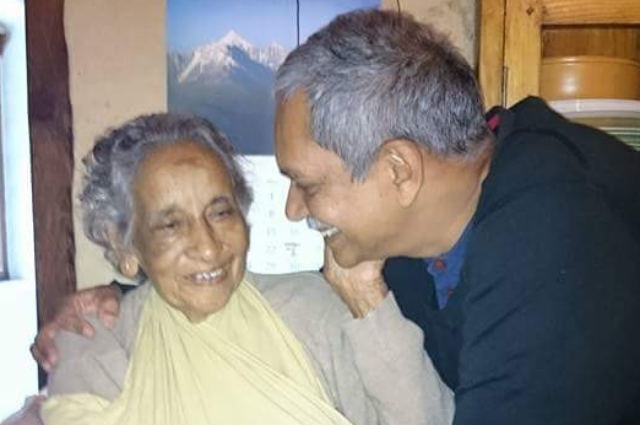
Nani and Sushil (Her last few days)
And with those fading memories, aachaar too began to dissolve into the mist. She no longer reached for mangoes in the summer. The questions stopped. The ritual quietened.
It was no secret—Nani ka aachaar had a fan following of its own. The sharp tang, the perfect balance of spice, and that glossy layer of oil on top—everyone knew this wasn’t something you could buy in a store or find in your average kitchen. It was the real deal.
She never advertised. She didn’t need to. She loved feeding people. She loved gifting jars wrapped in newspaper or tied with twine, as if handing over something sacred. And truthfully, she was. Her aachaar travelled far. Even today, I hear stories from people who remember those jars—not just for their flavor, but for the feeling that came with them. That feeling of being cared for. Of receiving something made slowly, with bare hands and big-hearted love.
Food is memory. Food is culture. Food is medicine
In homes across the world, old recipes are disappearing—quietly, like grandmothers who once stirred them into life.
Let’s not wait for a pandemic or nostalgia to wake us up. Let’s preserve more than the jars. Let’s preserve the people behind them. Ask questions. Cook together. Pass it on—but not just the recipe. Pass on the why behind it. Healing doesn’t only come from what we eat—it comes from remembering how we once made it, who made it for us, and why it mattered.
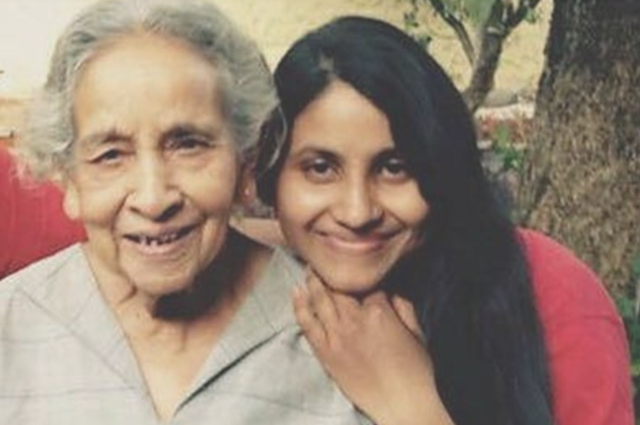
I wish I had documented your aachaar process—or at least taken pictures. But I was too young. Still, the memories that live in my mind today are, I think, stronger and deeper than any image could ever hold.
My Nani. I miss you - wherever you are.
